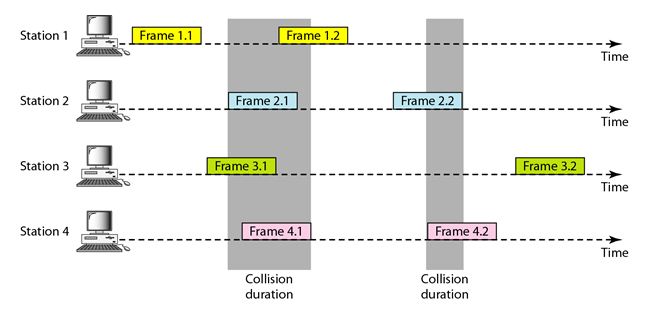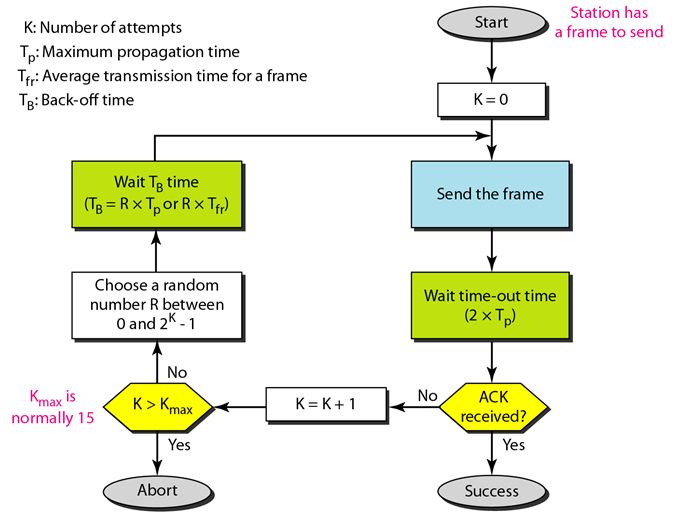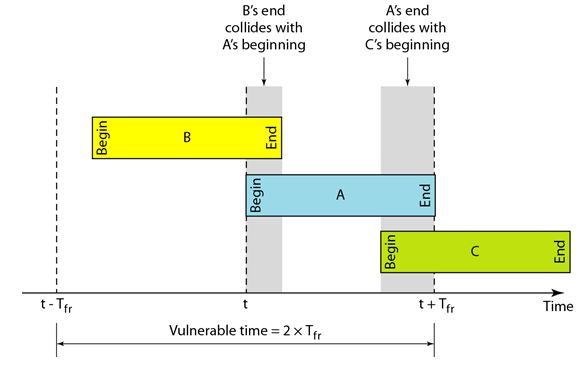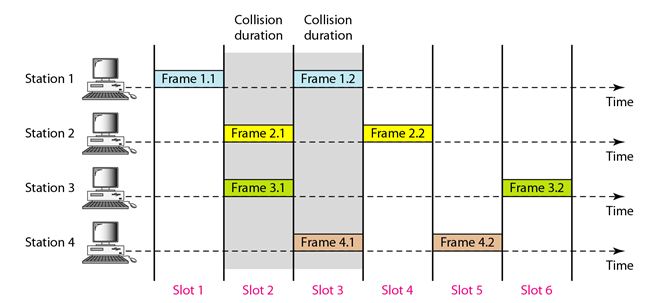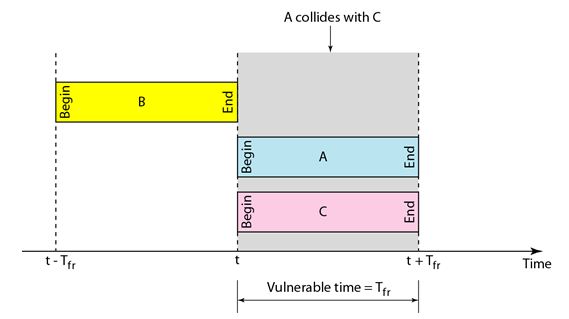ALOHA Protocols
ALOHA, the earliest random access method was developed at the University of Hawaii in early 1970. It was designed for a radio (wireless) LAN, but it can be used on any shared medium.
It is obvious that there are potential collisions in this arrangement. The medium is shared between the stations. When a station sends data, another station may attempt to do so at the same time. The data from the two stations collide and become garbled.
Pure ALOHA
The original ALOHA protocol is called pure ALOHA. This is a simple, but elegant protocol. The idea is that each station sends a frame whenever it has a frame to send. However, since there is only one channel to share, there is the possibility of collision between frames from different stations. The following figure shows an example of frame collisions in pure ALOHA.
There are four stations (unrealistic assumption) that contend with one another for access to the shared channel. The figure shows that each station sends two frames; there are a total of eight frames on the shared medium. Some of these frames collide because multiple frames are in contention for the shared channel.
Carrier Sense Multiple Access Protocol
Carrier Sense Multiple Access with Collision Detection
The above figure shows that only two frames survive: frame 1.1 from station 1 and frame 3.2 from station 3. We need to mention that even if one bit of a frame coexists on the channel with one bit from another frame, there is a collision and both will be destroyed.
It is obvious that we need to resend the frames that have been destroyed during transmission. The pure ALOHA protocol relies on acknowledgments from the receiver. If the acknowledgment does not arrive after a time-out period, the station assumes that the frame (or the acknowledgment) has been destroyed and resends the frame.
A collision involves two or more stations. If all these stations try to resend their frames after the time-out, the frames will collide again. Pure ALOHA dictates that when the time-out period passes, each station waits a random amount of time before resending its frame. The randomness will help avoid more collisions. We call this time the back-off time TB.
Pure ALOHA has a second method to prevent congesting the channel with retransmitted frames. After a maximum number of retransmission attempts Kmax a station must give up and try later. The following figure shows the procedure for pure ALOHA based on the above strategy.
The time-out period is equal to the maximum possible round-trip propagation delay, which is twice the amount of time required to send a frame between the two most widely separated stations (2 x Tp) The back-off time TB is a random value that normally depends on K (the number of attempted unsuccessful transmissions). The formula for TB depends on the implementation. One common formula is the binary exponential back-off.
In this method, for each retransmission, a multiplier in the range 0 to 2K - 1 is randomly chosen and multiplied by Tp (maximum propagation time) or Tfr (the average time required to send out a frame) to find TB' Note that in this procedure, the range of the random numbers increases after each collision. The value of Kmax is usually chosen as 15.
Vulnerable time:
The vulnerable time is in which there is a possibility of collision. We assume that the stations send fixed-length frames with each frame taking Tfr S to send. The following figure shows the vulnerable time for station A.
Station A sends a frame at time t. Now imagine station B has already sent a frame between t - Tfr and t. This leads to a collision between the frames from station A and station B. The end of B's frame collides with the beginning of A's frame. On the other hand, suppose that station C sends a frame between t and t + Tfr . Here, there is a collision between frames from station A and station C. The beginning of C's frame collides with the end of A's frame.
Throughput:
Let us call G the average number of frames generated by the system during one frame transmission time. Then it can be proved that the average number of successful transmissions for pure ALOHA is S = G x e-2G. The maximum throughput Smax is 0.184, for G = 1. In other words, if one-half a frame is generated during one frame transmission time (in other words, one frame during two frame transmission times), then 18.4 percent of these frames reach their destination successfully.
Slotted ALOHA:
Pure ALOHA has a vulnerable time of 2 x Tfr. This is so because there is no rule that defines when the station can send. A station may send soon after another station has started or soon before another station has finished. Slotted ALOHA was invented to improve the efficiency of pure ALOHA.
In slotted ALOHA we divide the time into slots of Tfr s and force the station to send only at the beginning of the time slot. The following figure shows an example of frame collisions in slotted ALOHA.
Because a station is allowed to send only at the beginning of the synchronized time slot, if a station misses this moment, it must wait until the beginning of the next time slot. This means that the station which started at the beginning of this slot has already finished sending its frame. But, still there is the possibility of collision if two stations try to send at the beginning of the same time slot. However, the vulnerable time is now reduced to one-half, equal to Tfr. The following figure shows the situation.
Throughput:
It can be proved that the average number of successful transmissions for slotted ALOHA is S = G x e-G. The maximum throughput Smax is 0.368, when G = 1. In other words, if a frame is generated during one frame transmission time, then 36.8 percent of these frames reach their destination successfully.
For Further Reading:
Carrier Sense Multiple Access with Collision Avoidance
Controlled Access Protocols
Channelization Protocols
Back to DCN Questions and Answers

